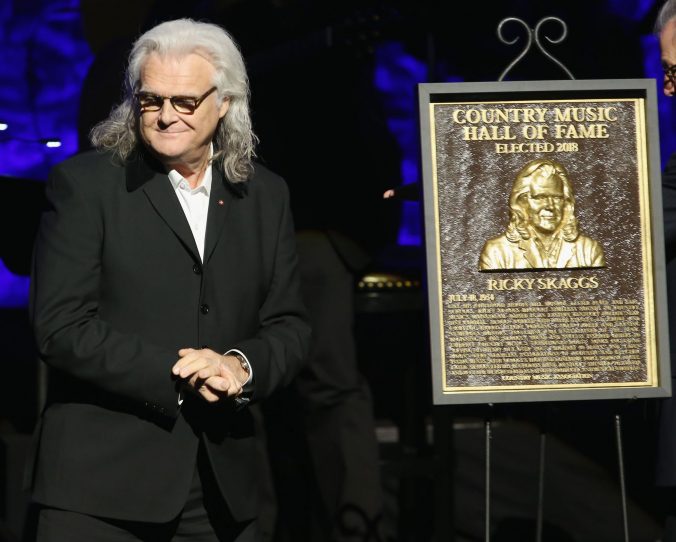The lineup of artists that welcomed Ricky Skaggs, Dottie West and Johnny Gimble into the Country Music Hall of Fame in Nashville Sunday night (Oct. 21) could have filled the cavernous Bridgestone Arena, which sat just across the street from the Hall, many times over.
Instead, it was a private audience of a few hundred people who had the privilege of hearing songs and stories from Garth Brooks, Dierks Bentley, Chris Stapleton, Connie Smith, Larry Gatlin, Steve Wariner, Jeannie Seely, David Ball, Larry Cordle, mandolin wizard Sierra Hall, the Americana duo The War and Treaty, fiddlers Michael Cleveland, Kenny Sears, Larry Franklin, Joe Spivey and Deanie Richardson and guitarist Jeff White. West died in 1991, Gimble in 2015.

Stories of musical instruments that became magic carpets also loomed large during the evening — the fiddle Gimble began playing when he was 10, the cheap guitar West won when she was 12 by selling Smith’s Rosebud Salve door to door and the $5 mandolin Skaggs father bought him in a Lima, Ohio pawnshop and then transported lovingly back to Eastern Kentucky to place as a surprise beside his sleeping five-year-old.
Then there was Bill Monroe’s priceless 1923 Lloyd Loar Gibson F-5 mandolin taken from its glass case in the Hall of Fame museum and given to Skaggs to play during the evening’s traditional finale, “Will the Circle Be Unbroken,” closing the three-hour ceremony.

While the audience was gathering, screens above the stage showed the members of each year’s Hall of Fame “class” since the institution was founded in 1961. Gimble, West and Skaggs are the 134th, 135th and 136th members, respectively.
Hall of Fame and Museum CEO Kyle Young hosted the proceeding, which has come to be known as the Medallion Ceremony because of the necklace-like medal awarded each new inductee.
Young chronicled Gimble’s rise from his youth in Tyler, Texas to the formation of his own bands to his inclusion in 1949 in Bob Wills’ superband, the Texas Playboys. He relocated to Nashville in 1968 and became an in-demand session musician, playing on the albums of such luminaries as Merle Haggard, Willie Nelson (once a bass player in Gimble’s own band), Dolly Parton, Marty Robbins, George Strait, Lefty Frizzell, Johnny Cash and Randy Travis.
Characterized as “open minded and open hearted,” Gimble seemed to take great joy in his fiddling, always lighting up the stage and sessions with his grins. His tenure as a Texas Playboy earned him a place in the Rock and Roll Hall of Fame in 1999.
In recognition of Gimble’s love of the jazz element in western swing music, David Ball, accompanied by the Time Jumpers’ fiddlers Sears, Spivey and Franklin, offered a high-spirited but ultra-smooth rendering of the old classic, “Right or Wrong,” the same song Strait took to No. 1 in 1984, with Gimble on fiddle.

Next on stage was Cleveland, an 11-time winner of the International Bluegrass Music Assn.’s fiddler of the year award, with his light-touch interpretation of Gimble’s own composition, “Gardenia Waltz.” White backed him on acoustic guitar.
Grand Ole Opry star and Hall of Fame member Connie Smith delivered the final musical tribute to Gimble, singing her 1972 hit, “If It Ain’t Love (Let’s Leave It Alone).” She had been so impressed by Gimble’s work on that record, she said, that she tried to get her label, RCA, to credit him as her duo partner. When the label refused, she sent a letter to disc jockeys asking them to take notice of his musical contribution.
Smith brought Gimble’s widow and children to the stage to participate in the unveiling of his bronze Hall of Fame plaque.
A series of videos and photos traced Dottie West’s progress from a gingham-wearing country girl to a spandex-clad Las Vegas vamp. In a voice-over narrative, Kenny Rogers, West’s frequent duet partner, declared, “Dottie was one of those people who believed what she sang.”
Young described West’s hardscrabble upbringing, dominated by an abusive father who was “a holy terror” and a mother so beaten down that she “practiced laughing in a mirror so she wouldn’t forget how.”
Ultimately, West (whose original name was Dorothy Marsh) put herself through college, married steel player Bill West, wrote lots of songs and began her slow march toward musical immortality.
That march would include duet pairings with Jim Reeves, Don Gibson, Jimmy Dean and finally Rogers and a wildly successful series of Coca-Cola ads that led to her 1973 hit, “Country Sunshine.”
Opry member Jeannie Seely, who West convinced to seek a career in Nashville, came to the stage to sing “Here Comes My Baby,” a song West and her husband wrote and one that earned her a Grammy in 1964 for best female country vocal.

Gatlin and Wariner, two talents West championed at the beginnings of their careers, followed Seely with a cool and casual reading of “Country Sunshine” that had the crowd clapping along.
West’s daughter, Shelly, who had her own country successes in the 1980s, chief among them her duet with David Frizzell, “You’re the Reason God Made Oklahoma,” sat in the front row with her brothers, gazing in rapt attention — and now and then raising her arm in affirmation — as Gatlin and Wariner sang.
The War and Treaty (Michael and Tanya Trotter) capped off the West segment with a hard-hitting cover of her 1980 hit — and her first No. 1 as a solo artist — “A Lesson in Leavin’.”

Hall of Famer Brenda Lee (both Country and Rock and Roll) emerged to induct West formally. “I’ve done a lot of this in my life,” she said, “but this is one of the most precious to me.” She credited West, Patsy Cline and songwriter Marijohn Wilkin for encouraging and nourishing her aspirations. Then she summoned to the stage Trisha Yearwood, Emmylou Harris, Jeannie Seely, Jan Howard and Connie Smith.
“Come on, you female girls,” she cracked. “The reason I’m doing this is that it takes a village to induct this woman. . . . She had the biggest heart. She was a good woman.”

Likening her own impoverished childhood to West’s, Lee continued, “She and I felt the safest when we were on stage. We felt like we could be who we were then.”
Shelly West told the crowd that even though her mother and father were on the road a lot, she had a loving and charmed childhood — not to mention the company of such personalities as Roger Miller and Willie Nelson. She recalled often waking to see the floor littered with songwriters.
Her brother, Dale, recounted recording with his mother the tearjerker “Mommy Can I Still Call Him Daddy” when he was four years old — with Chet Atkins producing.
Skaggs was a prodigy who, by the time he was seven years old, had played mandolin on stage with Bill Monroe and on television with Lester Flatt & Earl Scruggs. While still a teenager he, along with his good friend Keith Whitley, became members of Ralph Stanley’s fabled band, the Clinch Mountain Boys. These achievements proclaimed him a natural son to the main founding fathers of bluegrass music.
When Skaggs, signed to a major label and producing his own records, began regularly topping the country charts in the early 1980s, it became evident that his creativity ranged beyond bluegrass, even as the genre remained his musical core.
As Monroe lay dying, Skaggs often sat at his bedside. During one visit, he took the same mandolin Monroe had allowed him to play when he was six, and cheered the old man with a blazing romp through “Rawhide,” the instrumental Monroe had composed and made famous.
After playing in various other bluegrass configurations, Skaggs took a turn toward country as a member of Emmylou Harris’ Hot Band. There he reinforced Harris’ bluegrass underpinnings and dueted with her on “The Darkest Hour Is Just Before Dawn” on her 1980 Roses in the Snow album.
Brooks, Cordle and Hull kicked off the tribute to Skaggs with “Highway 40 Blues,” a song Cordle had written while he and Skaggs were still living in Eastern Kentucky and which Skaggs promised to record if he ever got a record deal.

He did better than that, arching the song to No. 1 in 1983 and turning it into a country and bluegrass standard. Brooks gave Cordle and Hull the spotlight, only occasionally moving forward to the microphone, his hands thrust in his pockets, to sing a verse or join in the harmony.
Next in line was Dierks Bentley, who fell in love with bluegrass during his frequent visits to Nashville’s Station Inn. He sang the mournful Skaggs hit, also from 1983, “You’ve Got a Lover.”
Bentley told the crowd that two of his band members had earlier worked in Skaggs’ band and that one of the first albums he’d bought while studying harmony was Skaggs and Whitley’s Second Generation Bluegrass.
“I’ll do what I can with this, Mr. Skaggs,” Chris Stapleton said humbly, as he launched into “The Darkest Hour Is Just Before Dawn.” And he did quite well, accompanying himself on guitar, as the Medallion Band seated behind him remained quiet. When he finished, he walked to the edge of the stage, leaned down and shook Skaggs’ hand.

Brooks returned to the stage to induct Skaggs. As usual, he presented himself as a bumbler, incapable, he claimed, of presenting Skaggs with the eloquence due him. Naturally, he was beyond eloquent. He described how Skaggs, Reba McEntire and George Strait had returned country music to its strongest roots while paving the way for the masterful Randy Travis.
He said there was “a thin line between craziness and genius” and that Skaggs’ apparent craziness — such as releasing the old Bill Monroe chestnut, “Uncle Pen,” as a single — became genius when the song soared to No. 1.
Brooks said all his teachers at Oklahoma State University boasted Ph. D. degrees but that none of them spoke to him, “a 19-year-old kid,” as forcefully as Skaggs’ music did.

Skaggs came up to claim his medallion and unveil his plaque that depicts him with the long-white hair he’s worn for the past several years. He lauded his mother and dad — not just for their musical encouragement but for their religious teachings as well. Then, gesturing toward his wife, Sharon White, he exclaimed, “And, oh, my sweet Sharon, how I love you always and forever.”
From there on Skaggs read through a list that included his two brothers, his children and grandchildren, all the members of his office staff, his attorney and publicist and various fundamentalist ministers, among whom were Billy and Franklin Graham and Bob Jones.

He said he could — and should — spend an entire evening thanking Harris for her help in bringing him to international attention. He said he was grateful, too, to country radio — “not now so much but back then.”
Finally, he directed his affections to Brooks. “Garth, you booger, you’ve done more for country music than anyone I know.”
Young told Brooks he should remove Skaggs’ medallion temporarily so it wouldn’t scratch Monroe’s treasured Gibson F-5, which he asked Skaggs to play as he led the crowd in “Will the Circle Be Unbroken.”
Holding the mandolin in front of him, Skaggs talked to it as if it were alive. “You look great,” he said. “What about [my] hair? Like a Shetland pony? Yeah, I’ve heard that.”
As he concluded the song and the crowd started drifting out of the auditorium. He said to the mandolin, “I know it’s lonely in there” [the glass museum case]. “No, I’m not going to drop you.”
Last month, Skaggs was inducted into the International Bluegrass Music Hall of Fame and in 2016 to the Musicians Hall of Fame.
Once the ceremonies were over, most of the crowd retreated to the museum’s sixth floor, overlooking downtown Nashville, where table after table of food, drink and desserts awaited them.
The Gibson F-5 did not attend.
As usual, the Medallion Band was the evening’s musical backbone. Its members were Biff Watson (bandleader and acoustic guitar), Eddie Bayers Jr. (drums), Thom Flora and Tania Hancheroff (vocals), Paul Franklin (steel guitar), Brent Mason (electric guitar), Carmella Ramsey (vocals and fiddle), Michael Rhodes (bass), Deanie Richardson (fiddle and mandolin), Matt Rollings (keyboard) and Jeff White (acoustic guitar and vocals).






